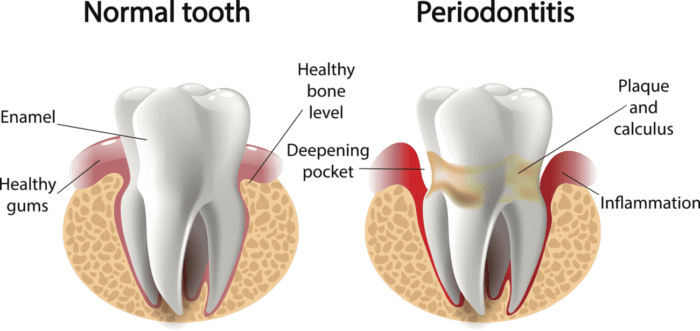Gum disease is often referred to as a “silent disease.” Many patients do seek treatment for gum disease until they are already showing signs that indicate the advancement of the disease such as bleeding gums. Some patients may not notice any pain or obvious symptoms until the condition has progressed. Our practice offers periodontal services for patients with gum disease.
Knowing the signs and symptoms of gum disease can help patients find treatment before the disease progresses or causes additional damage to the teeth or gums. Routine dental health exams are the most effective way to identify the early signs of gums disease. Our dentists perform a visual screening for periodontal disease during all exams.
If you notice any of the following symptoms or any other changes in your oral health, be sure to contact your dentist right away:
- Red, swollen or sore gums
- Bleeding gums when brushing or flossing
- Receding Gumline
- Loose teeth
- Pus between gums and teeth
- Sores in the mouth
- Halitosis
- Changes in the bite or fit of a denture
Poor oral hygiene is a major contributing factor in the development of gum disease. Twice daily brushing and flossing and routine dental health exams are the best ways to prevent gum disease. Other risk factors of gum disease include:
- Smoking or tobacco use of any kind
- Genetics
- Hormonal changes, particularly pregnancy
- Stress
- Missing Teeth
- Usage of certain medications
- Poor nutrition
- Diabetes

Treatment of periodontal disease is essential for avoiding more complex dental and systemic concerns. Left untreated, gum disease can cause halitosis, gum recession, and tooth loss. As the disease progresses patients’ oral health begins to deteriorate. Patients with advanced gum disease also experience a higher rate of cardiovascular disease, heart attacks, and inflammation.
We offer comprehensive periodontal therapy options for treating and reversing the early stages of gum disease. If caught early, the dentist is able to reverse gingivitis with a thorough cleaning of the teeth and gums. In more advanced cases, a scaling and root planing treatment may be required.
Scaling and root planing is an intensive cleaning treatment. Your dentist will perform a deep cleaning of the gums and teeth. This method of cleaning reaches into the pockets of the gums to remove bacterial build-up. Once the gums are cleared of bacteria, they are given the chance to heal. The doctor may make personalized recommendations for anti-bacterial mouth rinses and other products to help keep oral bacteria in check.
Our priority is to ensure that our patients are able to restore their optimal oral health. We will make every effort to coordinate with specialists that will provide patients with the services they need to fully restore their oral health. Patients with more complex cases of periodontal disease may be referred to Dr. Ed Lazer for advanced periodontal therapy treatments such as gum or bone grafting.
Frequently Asked Questions
Can children develop gum disease?
Yes. Children with poor oral hygiene or high rates of tooth decay are susceptible to developing gum disease. Patients who develop gum disease in their youth are more prone to oral and systemic disease later in life. Regular visits to our Owings Mills family dentist office can prevent the spread of gum disease in children and help to protect their health long term.
Is gum disease reversible?
If caught early, thorough dental cleanings and improved oral hygiene can prevent further damage from occurring to the teeth and gums. You can manage and treat advanced gum disease and secondary conditions to improve the patient’s oral health.
Can I cure bleeding gums at home?
When caught early, you can treat bleeding gums at home with a saltwater and baking soda rinse, diligent toothbrushing, and more. Although, this will not cure Gingivitis, Periodontitis, or advanced periodontal disease. You will need a dentist to cure your gum disease completely.
Is periodontal disease treatment expensive?
No. Dental insurance usually covers treatments for gum disease, periodontal disease, and bleeding gums. If you do not have dental insurance, we offer affordable dental financing plans so everyone can get the dental treatment they deserve.
How painful is periodontal treatment?
The pain level experienced during and after treatment can vary depending on the extent of the disease and the specific procedure performed. Basic treatments like scaling and root planing may cause mild discomfort or sensitivity. You can manage discomfort and sensitivity with over-the-counter pain relievers. On the other hand, more advanced surgical procedures might cause more discomfort. However, dentists and periodontists use local anesthesia during treatment, which numbs the area and can make the procedure itself pain-free.
How long does periodontal treatment take to heal?
The healing time after periodontal treatment varies based on the procedure and the individual’s overall health. For non-surgical treatments like deep cleanings (scaling and root planing), recovery is usually within a few days. However, there might be some tenderness or minor bleeding.
The initial healing could take a couple of weeks for surgical treatments, such as gum grafts or flap surgery. However, the gums may continue to mature and reshape for several months after surgery. It is important to follow your dentist or endodontist’s post-treatment care instructions and maintain good oral hygiene practices.
